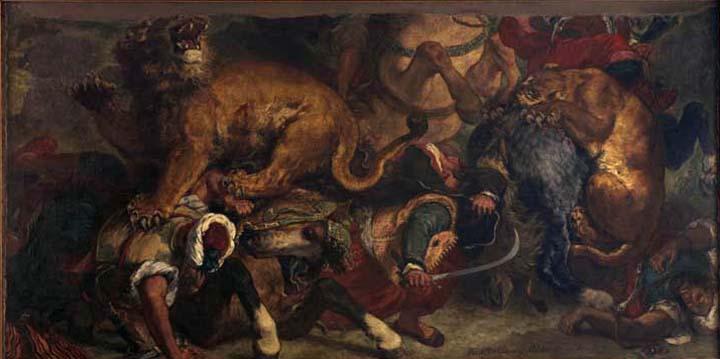Delacroix at The Met
“Art for art’s sake”—the antithesis of noble patronage—was a buzzword in bohemian Paris of the 1820s. But this was anathema to Eugène Delacroix, who was well-born but left an impecunious orphan at age 16. He was talented, ambitious, and competitive, with great plans for his future. Having Théodore Gericault as his mentor, and the diplomat Charles-Maurice de Talleyrand-Périgord, a cohort of his late father an ally, he knew the value of hard work and took advantage of every opportunity that came his way.
Instead of studying in Rome to further his art, which was common at the time, he concentrated on a rigorous practice of drawing from life, and at the Louvre Museum; taking illustration commissions for publication; and adopting the new art of lithography to make prints for sale.

“Passion for passion’s sake” might be more his mantra as the leading exponent of Romantic art from his debut at the Salon of 1822, at age 24 to his mature works that included mural commissions for public buildings and churches during the 1860s. Capturing the anguish of hand-to-hand combat on the battlefield in Massacre at Chios, his 1824 Salon entry based on contemporary events as Turkey attempted to subsume Greece into its empire, Delacroix made paint itself an equal subject of his work. A highly accomplished draftsman, the figures of his men, women, horses, lions, and other exotic creatures were so firmly etched in his mind that he was able to banish line as a structural device in his paintings. Instead he used paint to build form and space on a heroic scale—paint applied with a passion for its surface quality in a way quite new to French painting, which presaged the innovations of the Impressionists fifty years later.
The first full retrospective of his work in North America continues at The Metropolitan Museum of Art. Organized with the Louvre Museum, Paris, the show brings together close to 150 paintings, drawings and prints in a dozen galleries, each of which is painted in jewel-like colors that create the sense of individual gallery presentations.
Lion Hunt (1854-55)
Delacroix can be seen as the last of the great history painters, drawing on historical events filtered through the lens of mythology in Medea About to Kill her Children (1838); through the lens of biblical narrative, as in Christ in the Garden of Olives,(1824-26); through the lens of literature in Othello and Desdemona (1847-49) and rarely but exorbitantly in contemporary events such as Liberty Leading the People (1830), his most famous work, which remains behind at the Louvre. Although he cloaked his subjects in mythology, allegory, and historical equivalents, he clearly brought the tumultuous upheavals in Europe, and the three regime changes during his lifetime into his work.
Christ Asleep During the Tempest, 1853
Delacroix’s passion for getting it right—for finding an artistic truth in the spectacles that unfold on his canvases—relies to a large extent on his penchant for depicting
violence with a fearsome, awe-inspiring realism, which is the basic definition of Romanticism in art. In this sprawling retrospective, there are men killing men; men stabbing horses; horses destroying
one another; a woman about to off her kids; tigers devouring men; lions devouring men and tigers; and corpses of all species littering contested fields. The roiling commotion that creates worlds
within worlds in these scenes at first drew cheers and jeers in nearly equal measure, until the jeers were silenced by critical acclaim for the artist.
The faces of both the living and the dead who populate these paintings are drawn from life. Just as Delacroix posed for one of the dead in Raft of the Medusa for Gericault, he worked from life for the figures in the many large-scale oil sketches he did as presentations to his clients. It has been said he kept severed heads from the guillotine in his studio as models for the dead in his work—a believable mot considering the hideous pallor he conjured up in his paintings of those faces.
The Women of Algiers in their Apartment, 1834
Amid the chaos of the many battle scenes on view is an interior drawn from a harem he visited on his 1832 travels to North Africa. In Women of Algiers in Their Apartment (1834), three women, barefoot, in luxurious clothing and stoned on a hookah lounge on silken carpets with a black servant in attendance.*
Four women as the subject of an entire painting was unusual for the times, and Delacroix generally depicted women as metaphorical, rather than actual people, such as Liberty, Medea, and Greece on the Ruins of Missolonghi. In those paintings, the women are, literally, larger than life. They are self-possessed, commanding, and never in thrall to outside forces. In a sense, Delacroix has often shown women as equal players in his own pantheon of history. But in The Women of Algiers he revealed a scene from life that became a precursor of the modern era in art.
Women of Algiers became an icon for Orientalism that infused the art and design of Delacroix's time. This painting, in fact inspired many artists who followed, including Manet (Dejeuner sur l’herbe,1863); Frédéric Bazille (Reclining Nude, 1864; Young Woman with Peonies, 1870); Renoir (Parisian Women in Algerian Costume [The Harem], 1894); Matisse, in his many odalisque paintings of the 1920s; and Picasso (The Women of Algiers, 1955).
Delacroix continues through Jan. 6 at the Metropolitan Museum of Art. Info. Devotion to Drawing continues in adjacent galleries through Nov. 12. Info
*Orientalism, central to Delacroix’s work, became a feature of Western art at the height of the Colonial era. A new exhibition, The Black Model From Manet and Matisse to Today, will open October 24 at the Wallach Gallery at Columbia University, NY, NY Info MP031019





